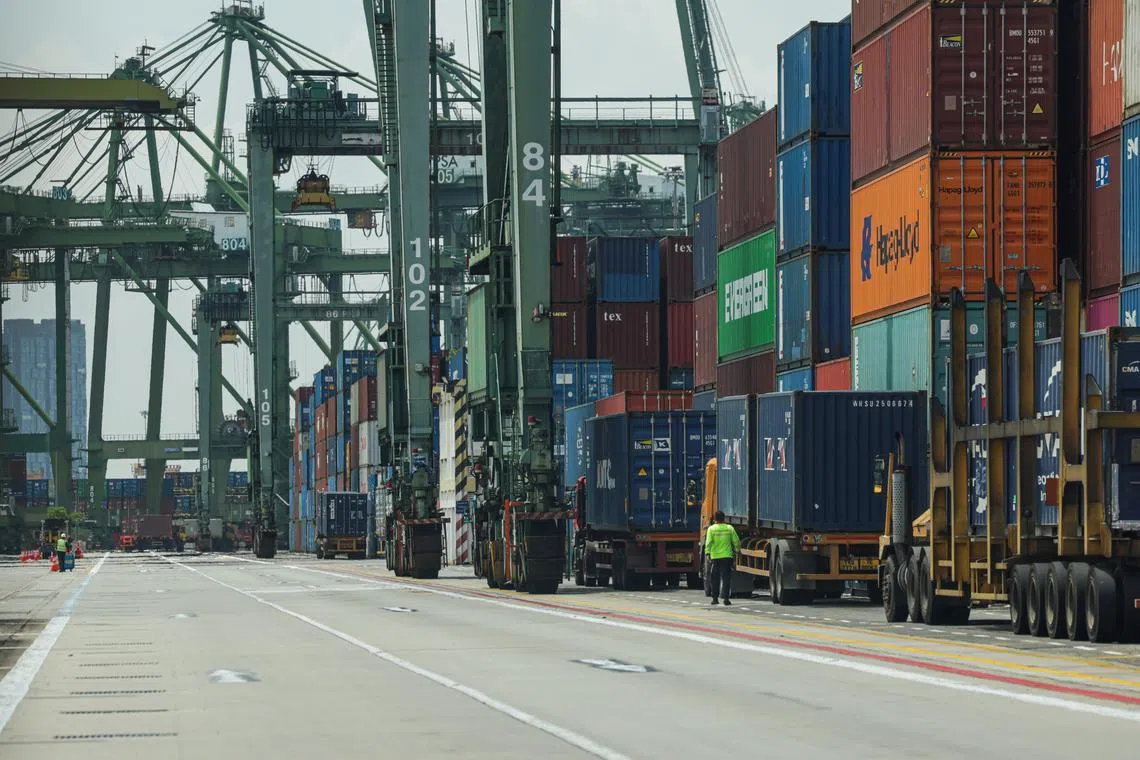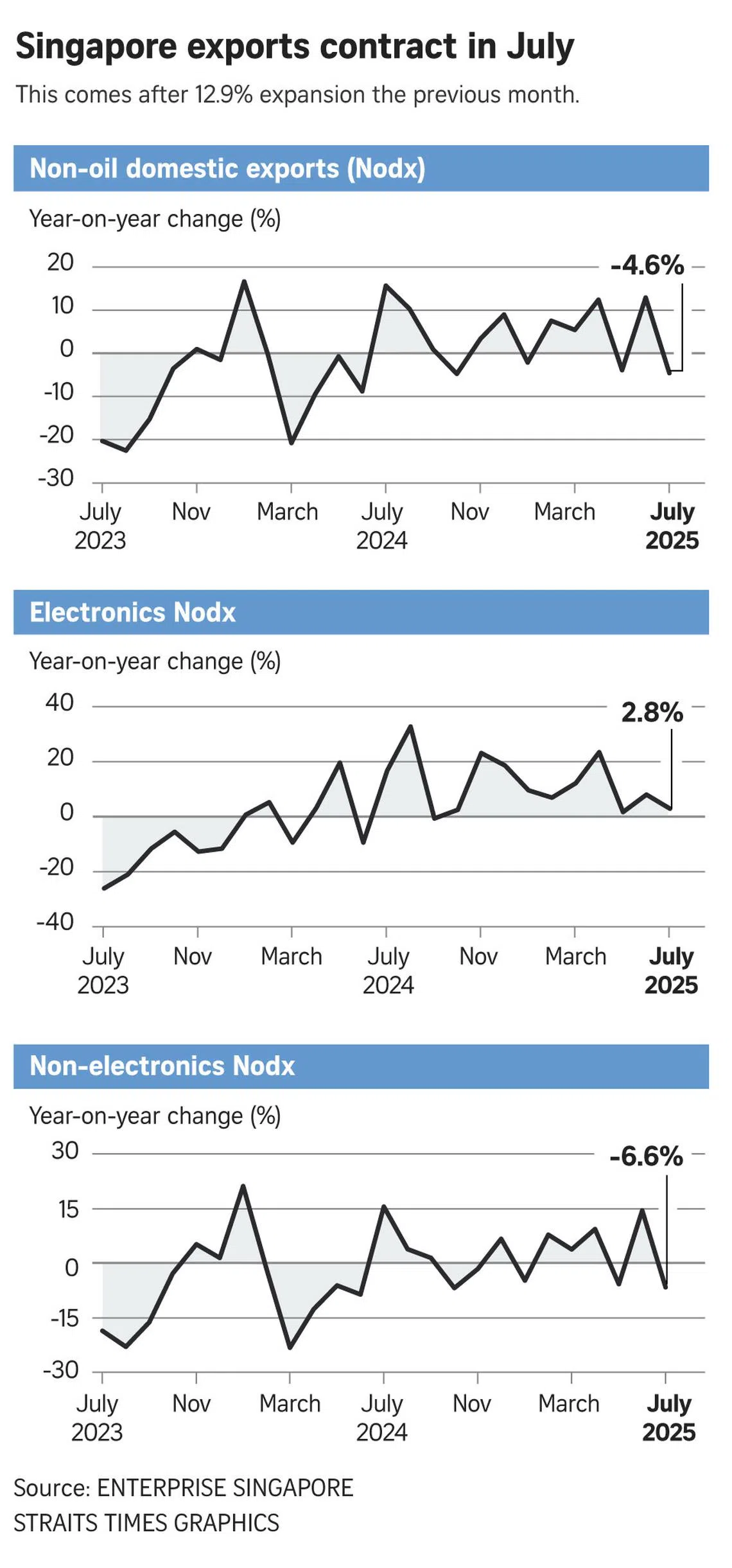Singapore’s key exports fall worse than expected in July as shipments to US plunge 42.7%
Sign up now: Get ST's newsletters delivered to your inbox

Non-oil domestic exports contracted 4.6 per cent in July from a year ago, amid a hit to pharmaceuticals.
ST PHOTO: GIN TAY
Follow topic:
- July data reveals a 4.6% contraction in Singapore's non-oil domestic exports (Nodx), signalling a payback from front-loading orders ahead of US tariffs.
- Key exports to the US plunged 42.7%, with potential US tariffs on semiconductors and pharmaceuticals posing a significant threat, according to DBS economist Chua Han Teng.
- Economists anticipate a tougher export future due to trade barriers, as Prime Minister Lawrence Wong stated, "small and open economies like us will feel the squeeze."
AI generated
SINGAPORE - Singapore’s key exports dropped more than expected in July, reversing from a rebound in June, as shipments to the US plunged more than 40 per cent.
The July data shows that payback from the front-loading of orders to get ahead of higher US tariffs has started to hit Singapore’s trade figures, said economists.
With US President Donald Trump’s reprieve from those higher tariffs having ended in August – and the looming threat of potential sectoral tariffs on semiconductors and pharmaceuticals – Singapore’s exports face a tougher and more uncertain future, they added.
Non-oil domestic exports (Nodx) contracted 4.6 per cent in July from a year ago, after a revised 12.9 per cent expansion in June, data from Enterprise Singapore (EnterpriseSG) on Aug 18 showed.
The reading was worse than the 1 per cent fall forecast by economists in a Bloomberg poll.
Key exports to the US, Singapore’s single largest export market, plunged 42.7 per cent, while shipments to China fell 12.2 per cent and those to Indonesia dropped 32.2 per cent.
DBS Bank senior economist Chua Han Teng said the weak Nodx data for July could be a sign of the beginning of weaker exports in the second half of 2025, compared with the resilience in the first half.
“Singapore’s electronics and biomedical shipments remain vulnerable to potential elevated US levies on semiconductor and pharmaceutical imports, which are currently under review,” said Mr Chua.
July’s worse-than-expected performance was partly due to the high base a year ago, particularly for pharmaceuticals.
Non-electronics shipments, of which pharmaceuticals are a big part, fell 6.6 per cent year on year in July, reversing the 14.4 per cent jump in the previous month.
The drop was led by an 18.9 per cent fall in pharmaceutical exports, a 23.4 per cent decrease for petrochemicals and a 26.3 per cent decline for food preparations.
Shipments of electronic products increased 2.8 per cent, but this was down from the 8 per cent growth in the previous month.
The rise came on the back of an 80.4 per cent surge in personal computer exports. Shipments grew 25.8 per cent for bare printed circuit boards and 8 per cent for integrated circuits, or chips.
OCBC Bank chief economist Selena Ling said in a note on Aug 12 that the crystal ball remains murky for now as Singapore still faces a 10 per cent reciprocal tariff for exports to the US, with the bigger question being whether there will be an exemption or concessions given for potential higher tariffs on semiconductors and pharmaceuticals.
Mr Trump proposed to initially impose a “small tariff” on pharmaceutical imports but said he could raise that rate to as high as 250 per cent in one to 1½ years’ time.
He also hinted at 100 per cent to 300 per cent tariffs on semiconductor imports but would allow for exemptions for firms that are moving manufacturing back to the US.
Said Ms Ling: “The impact of 100 per cent semiconductor tariffs is not negligible.
“Therefore, the question is then how much of such production may then reshore back to the US? At this juncture, it is still very uncertain – as what we have seen with the reciprocal tariffs, the eventual semiconductor tariff level may well change, and the firm exemption list may also evolve.”
UOB senior economist Alvin Liew said that potential drag from US reciprocal tariffs may be more pronounced in trade-related services, rather than in the manufacturing sector, as front-loading seems to be more pronounced in electronics exports and less so in non-electronics exports and manufacturing.
Any further growth drag in these sectors is likely to stem from weaker demand due to the tariffs, as well as the additional risks of US tariffs on semiconductors and pharmaceuticals, he added.
Ms Ling said that sustained positive electronics Nodx growth may not be sufficient to offset the weakness in non-electronics exports if pharmaceutical exports stay soft, especially amid the potential threat of US tariffs on these imports.
Prime Minister Lawrence Wong in his National Day Rally speech on Aug 17 said that he took “little comfort” from the 10 per cent baseline tariff rate
“Because no one knows if, or when, the US might raise the baseline, or set higher tariffs on specific industries like pharmaceuticals and semiconductors,” he said.
“What we do know is that there will be more trade barriers in the world. That means small and open economies like us will feel the squeeze,” he added.

EnterpriseSG on Aug 12 had kept its 2025 key exports forecast at the lower end of a 1 per cent to 3 per cent range, in anticipation of a weaker second half-year. This is after Nodx grew 7.1 per cent in the second quarter of 2025.
The trade agency said that continued economic uncertainty amid the evolving tariff situation could dampen demand from key trading partners, while sector-specific tariff risks remain.

